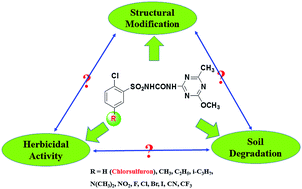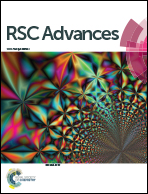Research on controllable degradation of sulfonylurea herbicides†
Abstract
In order to seek ecologically safer and environmentally benign sulfonylurea herbicides (SU), insight into the structure/bioassay/soil degradation tri-factor relationship was first established. With the introduction of various groups (alkyl, nitro, halogen, cyano etc.) at the 5th position of its benzene ring, structural derivatives of chlorsulfuron were designed, synthesized, and evaluated for their herbicidal activity. The structures of the title compounds were confirmed by infrared spectroscopy, ultraviolet spectroscopy, 1H and 13C NMR, mass spectrometry, elemental analysis and X-ray diffraction. Bioassay results confirmed that most derivatives retained their superior herbicidal activities in comparison with chlorsulfuron. After investigating the soil degradation behavior of each molecule under set conditions, it was found that structures with electron-withdrawing substituents at the 5th position of the benzene ring retained their long degradation half-lives, yet the introduction of electron-donating substituents accelerated the degradation rate. These results will provide a valuable clue to further explore the potential controllable degradation of SU and other herbicides, and to discover novel herbicides that are favorable for environmentally and ecologically sustainable development.


 Please wait while we load your content...
Please wait while we load your content...